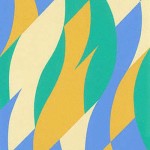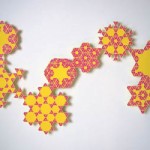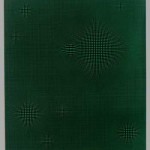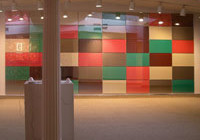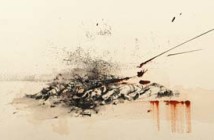In 1938, Victor Vasarely, a Hungarian-born artist, painted “Zebra” - claiming that the optical illusion generated from the black and white pattern on a two-dimensional surface was the objective. Although Vasarely is considered the originator, the term Op Art was not coined until 1964, in an issue of Time Magazine.
Op Art defined a group of abstract artists in America who experimented with geometric designs, in black and white or a combination of colors. Joseph Albers, in his Homage to the Square series, experimented with color placement and its effect on visual perception with th square. Two dimensional paintings by Bridget Riley came alive through precise, mathematical compositions - producing the illusion of breathing and movement. Although some Op Art provoked psychedelic illusions, enhancing a viewer’s perception on mind-altering substances, Op Art originally was not intended to induce emotion. The look of the work is what drew the public eye. Soon after, black-and-white wavy lines, rolling checkerboard patterns, and colorful groovy works made their mark on American fashion, interior design, and household products.
In the sixties, Op Art hardly created the explosion of Pop Art. Under Leo Castelli’s guidance, Lichtenstein’s enlargened comics, Warhol’s sodium-filled soup cans, and Wesselman’s factory-packaged consummables became hot commodities for New York and European collectors. Of a different character, Op Art’s physical surface reflected its sole subject. Pop Art, on the other hand, mirrored the surface mentality of its subjects - mainstream American consumer culture.
Op-ish, a full-house exhibition at Samson Projects, pays homage to the Op Art of the 60’s, with works by Joseph Albers and Bridget Riley, while promoting contemporary artists who seemingly appear to be visual revivalists of Op. Fortunantly, unlike surface post-modernists like Haim Steinbach and Ashley Bickerton, the strongest artists in Op-ish go beyond the surface.
Gabe Johnson, a young graduate of Mass College of Art and an emerging talent in Boston, sculpts illusionistic collage constructions from discarded lottery tickets. Johnson visualizes compositions, cuts shapes from existing text and images, and assembles these fragments into engaging, diverse works. Like the Dadaist Kurt Schwitters, who transformed trash from the streets of theater districts into assemblages with remnants of bourgeois entertainment, Johnson turns used lottery tickets from convenient store garbage bins into intriguing compositions - immortalizing the failed hopes of American dreamers who want to become millionaires.
In Lucky 7’s, a work composed of adjoining triangles, various numbers, dollar signs, and the word "prize" remain intact within the composition. Pharoah’s Gold, simulating a woven fabric, shows segments of white dollar signs against a black background, within three horizontal sections of the construction. Miniature eyes illlusionistically come together as a weave, juxtaposed against a predominantly gold and green textured background.
The multi-talented Assume Vivid Astro Focus (aka Eli Sudbrak), a Rio-born artist residing in New York City, typically refers to youth culture in his psychedelic, Peter Max-inspired installations and public collaborations. Without this knowledge, one might thinkXanadu, a hi-fi print with glowing pink, orange, and violet cross-hatches - illusionistically projecting from a purple space - is simply a remarkable visual delight.
Linda Besemer, a widely-exhibited Los Angeles based feminist artist, intrigues the viewer with her Multi Bulge Sheet No. 5 - a dark green patterned mass of acrylic paint with pulsating bulges of varying sizes, breathing from an enclosed space. By combining Op Art and Neo-Geo with a touch of sensuality, the abstract self-proclaimed Besemer stands superior to an emotionally cool revivalist of Op.
The hip, retro look of Opish-art brings one back to the politics of the 60's. Gabe Johnson focuses on money-hungry escapists, those interested in financial cushioning as an answer to spiritual bankrupty. Assume Vivid Astro Focus shows the essential need for community out-reach towards the underdogs in society through groovy patterns; while Linda Besemer addresses her feminist views -visually challenging the notion that abstract expressionism is limited to the boys’ club.
Contemporary Op-ish art is the embodiment of hip -mirroring the retro 70’s look, currently in vogue; but unlike the impact Op made on modern patterns in mainstream culture in the 60’s, today’s fashion rehashes the look of the 70s, while impacting the surface appeal of Op.
- Bridget Riley, Fold, 2004.
- Gabe Johnson, Pink Lemonade, 2005.
- Linda Besemer, Multi Bulge Sheet No. 5, 2004.
Links:
Samson Projects
"Op-ish" is on view insert date at Samson Projects, located at 450 Harrison in the SOWA district.
All images are courtesy of the artists and Samson Projects.


